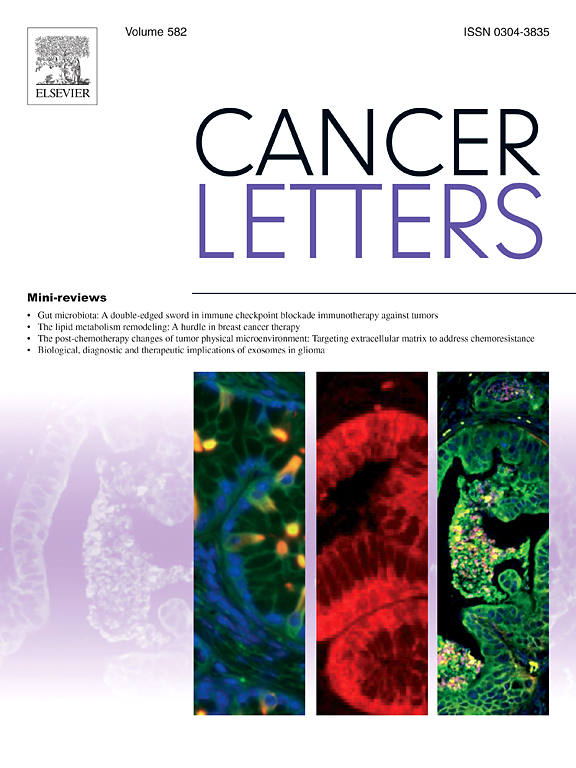SIK1 promotes ferroptosis resistance in pancreatic cancer via HDAC5-STAT6-SLC7A11 axis
IF 9.1
1区 医学
Q1 ONCOLOGY
引用次数: 0
Abstract
The activation of protein kinases is ubiquitous in pancreatic ductal adenocarcinoma (PDAC), yet its impact on ferroptosis remains unclear. SIK1 was identified as a key regulator of ferroptosis resistance in PDAC by kinase database screening. Targeting SIK1 could significantly reverse ferroptosis resistance and enhance cytotoxic effects of gemcitabine via increasing ferroptosis sensitivity in PDAC cells. Mechanistically, SIK1 phosphorylated HDAC5 at Ser498 residue and promoted its interaction with 14-3-3 protein, which further protected HDAC5 from TRIM28-mediated ubiquitylation and degradation. SIK1-stabilized HDAC5 deacetylated STAT6 and enhanced its transcriptional activity to upregulate SLC7A11 expression, ultimately rendering PDAC cells resistance to ferroptosis. SIK1 inhibitor (YKL-05-099) could synergistically enhance the antitumor effects of gemcitabine in organoid and patient-derived xenograft (PDX) models by inducing ferroptosis, suggesting a novel therapeutic target for PDAC. Clinically, SIK1 was positively correlated with SLC7A11 expression in PDAC specimens, which was associated with poor prognosis. These findings unveil a crucial mechanism through which PDAC counters ferroptosis via SIK1-mediated HDAC5 stabilization and subsequent SLC7A11 upregulation. This study underscores the promising potential of targeting SIK1-HDAC5 axis as a therapeutic strategy to overcome drug resistance in PDAC.
SIK1通过HDAC5-STAT6-SLC7A11轴促进胰腺癌铁下垂抵抗
蛋白激酶的激活在胰腺导管腺癌(PDAC)中普遍存在,但其对铁下垂的影响尚不清楚。通过激酶数据库筛选,发现SIK1是PDAC中铁下垂抗性的关键调节因子。靶向SIK1可以通过增加PDAC细胞对铁下垂的敏感性,显著逆转铁下垂耐药性,增强吉西他滨的细胞毒作用。机制上,SIK1磷酸化HDAC5的Ser498残基,促进其与14-3-3蛋白的相互作用,进一步保护HDAC5免受trim28介导的泛素化和降解。sik1稳定的HDAC5使STAT6去乙酰化,并增强其转录活性,上调SLC7A11的表达,最终使PDAC细胞抵抗铁下垂。SIK1抑制剂(YKL-05-099)可通过诱导铁下垂,协同增强吉西他滨在类器官和患者来源的异种移植(PDX)模型中的抗肿瘤作用,提示PDAC的新治疗靶点。临床上,SIK1与SLC7A11在PDAC标本中的表达呈正相关,与预后不良相关。这些发现揭示了PDAC通过sik1介导的HDAC5稳定和随后的SLC7A11上调来对抗铁下垂的关键机制。这项研究强调了靶向SIK1-HDAC5轴作为一种克服PDAC耐药的治疗策略的潜力。
本文章由计算机程序翻译,如有差异,请以英文原文为准。
求助全文
约1分钟内获得全文
求助全文
来源期刊

Cancer letters
医学-肿瘤学
CiteScore
17.70
自引率
2.10%
发文量
427
审稿时长
15 days
期刊介绍:
Cancer Letters is a reputable international journal that serves as a platform for significant and original contributions in cancer research. The journal welcomes both full-length articles and Mini Reviews in the wide-ranging field of basic and translational oncology. Furthermore, it frequently presents Special Issues that shed light on current and topical areas in cancer research.
Cancer Letters is highly interested in various fundamental aspects that can cater to a diverse readership. These areas include the molecular genetics and cell biology of cancer, radiation biology, molecular pathology, hormones and cancer, viral oncology, metastasis, and chemoprevention. The journal actively focuses on experimental therapeutics, particularly the advancement of targeted therapies for personalized cancer medicine, such as metronomic chemotherapy.
By publishing groundbreaking research and promoting advancements in cancer treatments, Cancer Letters aims to actively contribute to the fight against cancer and the improvement of patient outcomes.
 求助内容:
求助内容: 应助结果提醒方式:
应助结果提醒方式:


